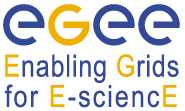European Grid Infrastructure
| European Grid Infrastructure | |
|---|---|
 | |
| Web address |
www |
| Commercial? | No |
Type of site | Scientific support |
| Launched | 2010 |
The European Grid Infrastructure (EGI) is a series of efforts to provide access to high-throughput computing resources across Europe using grid computing techniques.[1] The EGI links centres in different European countries to support international research in many scientific disciplines. Following a series of research projects such as DataGrid and Enabling Grids for E-sciencE, the EGI.eu organization was formed in 2010 to sustain the services of the EGI.[2]
Purpose
Science has become increasingly based on open collaboration between researchers across the world. It uses high-capacity computing to model complex systems and to process experimental results. In the early 21st century, Grid computing became popular for scientific disciplines such as high-energy physics, bioinformatics to share and combine the power of computers and sophisticated, often unique, scientific instruments in a process known as e-Science.[2]
In addition to their scientific value, on 30 May 2008 The EU Competitiveness Council promoted "the essential role of e-infrastructures as an integrating mechanism between Member States, regions as well as different scientific disciplines, also contributing to overcoming digital divides."[3]
EGI is partially supported by the EGI-InSPIRE EC project.
History

The European DataGrid project was first funded in 2001 for three years as one of the Framework Programmes for Research and Technological Development series.[4][5] Fabrizio Gagliardi was project manager of DataGrid and its budget was about 12 million Euro, with the full project named "Research and Technological Development for an International Data Grid".[6]
A major motivation behind the concept was the massive data requirements of the Large Hadron Collider project of the Organisation Européenne pour la Recherche Nucléaire (CERN).[7]
EGEE
On 1 April 2004 the Enabling Grids for E-Science in Europe (EGEE) project was funded by the European Commission through the Directorate-General for Information Society and Media, led by the information technology division of CERN.[8] This 24-month project of the Sixth Framework Programme had a cost of over 46 million Euro. The consortium included 70 institutions in 27 countries.[8] The LHC Computing Grid continued to be a major application of EGEE technology.[9] By 1 April 2006 the "in Europe" was dropped from the project name, but the acronym was kept as EGEE-II for Enabling Grids for E-sciencE. This two-year phase cost about 52.6 million Euro.[10] The new name reflected a more global extent, such as a cluster of computers at the Institute Of Microelectronic Systems in Malaysia.[11] By 2007 the EGI was supported by 36 countries.[12]

A middleware software package known as gLite was developed for EGEE.[13]
A third two-year project phase was called EGEE-III, running from 2008 to 2010. On 30 April 2010 the EGEE project ended.[14] By 2009 the governance model evolved towards a European Grid Initiative (EGI), building upon National Grid Initiatives (NGIs).[15]
Related projects
Diligent
A project called Diligent (digital library infrastructure on grid enabled technology) was funded from 1 September 2004 to 30 November 2007, and developed software called gCube somehow related to the EGEE technology.[16] This project cost more than 8.9 million Euro.[17] Follow-on projects called distributed collaboratories infrastructure on grid enabled technology 4 science (D4SCIENCE) cost about 3.9 million Euro through the end of 2009,[18] and 5.4 million Euro until September 2011.[19]
BEinGRID
A project on Business Experiments in GRID (BEinGRID) ran from 1 June 2006, through November 2009, with a cost estimated 23.6 million Euro.[20] The project published 25 case studies.[21] One participant observed in 2008 "a reluctant and slow take-off of Grid technology by the industry."[22]
Design study
The EGI Design Study (EGI_DS) project was launched in September 2007 and continued until the end of December 2009. The project was partially funded by the European Commission's 7th Framework Programme in order to: evaluate requirements and use cases, identify processes and mechanisms for establishment, define the structure, and initiate the organization.[23][24]
The study was directed by Dieter Kranzmüller, and cost about 3.9 million Euro.[1][25] In October 2008 site selection for EGI was begun.[26] Participants included 37 national projects.[27]
Structure
In March 2009, the policy board of the EGI announced it would be hosted in Amsterdam, the Netherlands at the Science Park Amsterdam.[28] The EGI.eu foundation was officially formed on 8 February 2010 in Amsterdam.[29] The name change included using infrastructure as the third word for the acronym, to reflect the transition from a series of short-term research projects to a more sustainable service.[30]
National Grid Initiatives (NGI) support scientific disciplines for computational resources within individual countries. The EGI is governed by a Council of representatives from each member NGI, which controls an executive that manages the international collaboration between NGI, so that individual researchers can share and combine computing resources in international collaborative research projects.
The governance model of the EGI coordinating the collaboration of National Grid Initiatives uses general policies of co-operation and subsidiarity adopted in the European Research Area.
A 32 million Euro project named the EGI-Integrated Sustainable Pan-European Infrastructure for Research in Europe (EGI.INSPIRE) was funded in September 2010 under direction of Steven Newhouse.[31] A 1.5 million Euro project called e-ScienceTalk was funded in 2010 for 33 months to support websites and publications covering the EGI.[32] It followed an earlier programme known as GridTalk that was funded from 2008 to 2010.[33][34]
See also
- Supercomputing in Europe
- eScience
References
- ↑ 1.0 1.1 Christopher Lazou (14 April 2008). "Grid Infrastructure Organization". European Parliament Magazine 265. pp. 8–9. Retrieved 2 October 2011.
- ↑ 2.0 2.1 "History of EGI". EGI.eu website. Retrieved 4 October 2011.
- ↑ European Competitiveness Council, Conclusions on European Research Infrastructures and their regional dimension, Brussels, 3 June 2008
- ↑ "EGEE‐III Project Publishable Summary". Enabling Grids for E-sciencE. 8 June 2010. Retrieved 2 October 2011.
- ↑ "The DataGrid Project". CERN. March 2004. Retrieved 2 October 2011.
- ↑ "Research and Technological Development for an International Data Grid". Project IST-2000-25182 description. European Community Research and Development Information Service. Retrieved 7 October 2011.
- ↑ Robert J. Wilson (22 October 2001). "The European DataGrid Project". Snowmass 2001 (American Physical Society). Retrieved 2 October 2011.
- ↑ 8.0 8.1 "Enabling grids For E-science". Project description. European Community Research and Development Information Service. Retrieved 2 October 2011.
- ↑ LHC Computing Grid: Technical Design Report. document LCG-TDR-001, CERN-LHCC-2005-024 (The LCG TDR Editorial Board). 20 June 2005. ISBN 92-9083-253-3. Retrieved 3 October 2011.
- ↑ "Enabling grids for E-sciencE-II". Project description. European Community Research and Development Information Service. Retrieved 2 October 2011.
- ↑ Jo Timbuong (24 April 2008). "Computer grid grows in power". The Star Online (Kuala Lumpur). Retrieved 2 October 2011.
- ↑ Leena Jukka (5 September 2007). "36 national grids initiatives in Europe support the EGI concept". Innovations Report. Retrieved 3 October 2011.
- ↑ "gLite – Lightweight Middleware for Grid Computing". CERN. Retrieved 3 October 2011.
- ↑ "EGEE Portal: Enabling Grids for E-sciencE". Official web site. Archived from the original on 19 June 2010. Retrieved 2 October 2011.
- ↑ "ICT Infrastructures for e-Science". Communication from the Commission to the European Parliament, the Council, the European Economic and Social Committee of the Regions. Brussels. 5 March 2009. Retrieved 2 October 2011.
- ↑ "Diligent Project". Defunct website. Archived from the original on 4 November 2008. Retrieved 3 October 2011.
- ↑ "A testbed digital library infrastructure on grid enabled technology". Project description. European Community Research and Development Information Service. Retrieved 3 October 2011.
- ↑ "DIstributed colLaboratories infrastructure on Grid enabled technology 4 science". Project description. European Community Research and Development Information Service. Retrieved 3 October 2011.
- ↑ "Data Infrastructure Ecosystem for Science". Project description. European Community Research and Development Information Service. Retrieved 3 October 2011.
- ↑ "Business experiments in GRID". Project 034702 fact sheet. European Community Research and Development Information Service. Retrieved 9 October 2011.
- ↑ "Business Experiments in Grid: BEinGRID". Project web site. European Community Research and Development Information Service. Archived from the original on 23 July 2011. Retrieved 9 October 2011.
- ↑ Claire Gresty, George Thanos, Theo Dimitrakos, Paul Warren (January 2008). "Service oriented infrastructure: Meeting customer needs". BT Technology Journal 26 (1). Retrieved 9 October 2011.
- ↑ "European Grid Initiative Design Study". Official website. 2009. Retrieved 2 October 2011.
- ↑ "Europeans connecting through the Grid". European Research Headlines (European Commission). 14 September 2007. Retrieved 3 October 2011.
- ↑ "European grid initiative design study". Project 211693 description. European Community Research and Development Information Service. Retrieved 2 October 2011.
- ↑ "Euroopan grid-organisaatio hakee kotipaikkaa". Digitoday (in Finnish). 17 October 2008. Retrieved 2 October 2011.
- ↑ "Scientists join forces to create European grid computing infrastructure". News release (European Community Research and Development Information Service). 25 September 2007. Retrieved 2 October 2011.
- ↑ "European Grid Initiative Head Office comes to Science Park Amsterdam". News release (University of Amsterdam). 23 March 2009. Retrieved 2 October 2011.
- ↑ Rob van der Meer (11 February 2010). "EGI.eu founded". News release (EGI.eu). Retrieved 3 October 2011.
- ↑ "Establishing EGI.eu". Projects (British Publishers). p. 26. Retrieved 3 October 2011.
- ↑ "Work on pan-European grid infrastructure moves to next level". News release (European Community Research and Development Information Service). 16 September 2010. Retrieved 2 October 2011.
- ↑ "e-ScienceTalk: Supporting Grid and High Performance Computing reporting across Europe". Project 260733 summary. European Community Research and Development Information Service. 1 September 2010. Retrieved 4 October 2011.
- ↑ "GridTalk: co-ordinating grid reporting across Europe". Project 223534 summary. European Community Research and Development Information Service. 1 May 2010. Retrieved 4 October 2011.
- ↑ "About GridTalk". Official website. 2010. Archived from the original on 4 October 2011. Retrieved 4 October 2011.